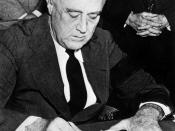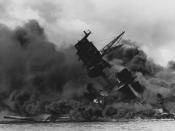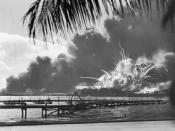During the 1930s, the U.S. watched Japan with growing concern for their aggressive territorial expansion. Japan was on a campaign to rule Southeast Asia and to build an empire. President Franklin D. Roosevelt took necessary precautions to ensure that this did not happen. He moved the main core of the U.S. Pacific Fleet from the west coast of the mainland of the U.S. to Hawaii, on the island of Oahu, at Pearl Harbor, in an attempt to strengthen the nation's military presence. The U.S. would then cut off oil exports to Japan. Without the U.S. supplying Japan with oil, the nation's military and industrial forces soon came to a standstill. Japan responded by joining the Axis alliance with Italy and Germany which the U.S. saw as a serious threat. The tension between the U.S. and Japan continued to grow. Eventually, this tension would lead up to the severing of diplomatic relations between Japan and the U.S.
The United States would be sucked into the Second World War after the bombing of Pearl Harbor on December 7, 1941, a date which will live in infamy.
The relationship between Japan and the United States was becoming more and more unstable. Japan was desperate to expand its empire but the U.S. disagreed with their expansion policy. The small island nation did not have the space or the resources to support its large population. Many of the countries that Germany had taken control of in Europe had control over colonies in the East Indies, Singapore, and other locations in Southeast Asia. These countries had natural resources that Japan desperately needed. When the motherlands of these colonies were in trouble in Europe, They lost focus on their colonies and Japan took over.
The U.S. and Japan seemed to fight back and forth with displays of...


